#classic film soundtracks
Explore tagged Tumblr posts
Text
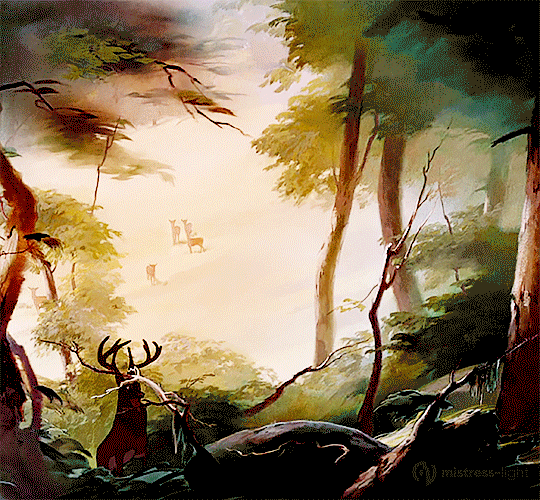
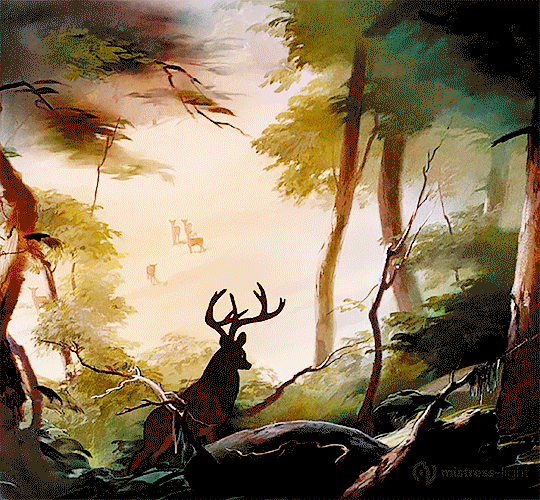
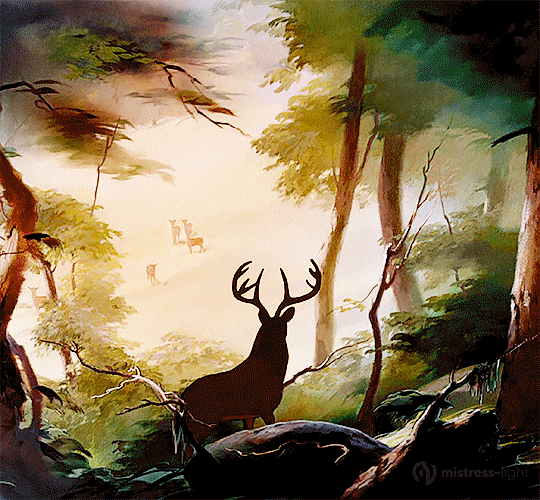
Everyone respects him. For of all the deer in the forest, not one has lived half so long. He's very brave and very wise. That's why he's known as the Great Prince of the Forest.
#bambi 1942#bambiedit#disneyedit#filmedit#disneydaily#userstream#moviegifs#disneyfolk#fyeahdisney#disneyfeverdaily#disney#film#my stuff#yocalio#i really like this disney movie ok?#a true classic#but i'm shit at making movie gifs ;A;#but this scene#the soundtrack uuhuhuhuh
1K notes
·
View notes
Text

#Show Tunes#Film Soundtrack#Modern Classical#Rock Musical#Progressive Rock#1980s#1990s#2000s#UK#poll#Spotify
118 notes
·
View notes
Text

Tracklist:
Two Worlds • You'll Be In My Heart • Son Of Man • Trashin' The Camp • Strangers Like Me • Two Worlds Reprise • Trashin' The Camp (Phil And *NSYNC Version) • You'll Be In My Heart (Phil Version) • Two Worlds (Phil Version) • A Wondrous Place • Moves Like An Ape, Looks Like A Man • The Gorillas • One Family • Two Worlds Finale
Spotify ♪ YouTube
#hyltta-polls#polls#artist: phil collins#artist: mark mancina#language: english#language: instrumental#decade: 1990s#Film Soundtrack#Pop Rock#Adult Contemporary#Film Score#Cinematic Classical#Classical Crossover#Afro-Rock
20 notes
·
View notes
Text


Friday the 13th bloody vinyl
#friday the 13th#friday the thirteenth#horror#jason#jason voorhees#victor miller#kevin bacon#betsy palmer#adrienne king#harry crosby#laurie bartram#mark nelson#jeannine taylor#robbi morgan#film#movie#music#classic#soundtrack#80s
547 notes
·
View notes
Text
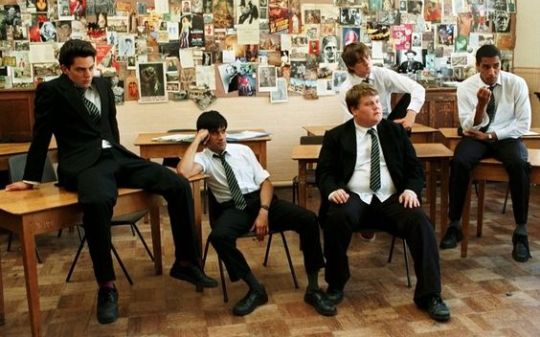
I appreciate and understand the love for Dead Poets Society in the Marauder-era fandom. The aesthetic is immaculate.
As a Brit and an older fan I would like to make a public service announcement that you're all sleeping on The History Boys. And would encourage everyone to go watch it.
#mauraders#wolfstar#the marauders#dead gay wizards#history boys#the history boys#marauder era#marauder coded#this film is a more accurate representation of the British school experience#plus it's a queer classic#the dialogue is *chefs kiss*#the performances are amazing#the references to art and film and music and literature are 10/10#public service announcement#alan bennett is incredible#give it a go#examines class and education in Britain#the film soundtrack is also amazing#is also more diverse than dead poets society
50 notes
·
View notes
Text
Fendrix - Soundtrack for the film Poor Things (2023)
I've probably said this before but I usually don't post film music on this blog. Mainly because it's questionable how much a score for a film could be considered "classical" or of the classical tradition. On the one hand, the kinds of genre and styles used for films, and the specific function of the music as accentuating or being part of the overall finished work of the film makes it out to be its own unique genre. On the other hand, classical composers in history have written incidental music for stage plays as well as scores for films, from early / classic film scores by Saint-Saëns or Prokofiev or later in the century by Takemitsu or Glass and going through to today. Regardless I had heard this music before seeing the film Poor Things and was immediately taken in. I loved it so much that I was disappointed that it did not win the Oscar for best film score this weekend (though I won't complain much because the winning score by Ludwig Göransson for Christopher Nolan's Oppenheimer was evocative and intense so it was worthy of the award and praise). Still I have a soft spot for Jerskin Fendrix's imaginative and otherworldly music fitting for the equally "otherworldly" and fantastical atmosphere that the world of Poor Things tries to evoke. Yorgos Lanthimos is one of my favorite living directors and I was excited to see this film, even moreso after hearing the score. While I love the exuberant style, unique cinematography, and the dreamlike images, I will admit I was somewhat disappointed by the film overall (I didn't love it as much as I did his 2018 film The Favourite), and am still uneasy and disturbed by the subject matter and implications of an infant/prepubescent mind developing in the body of an adult woman, and all of the uncomfortable sex scenes and conversations as the film goes along. Still, I do love this score as a stand-alone album. Bella's theme is awkward, slightly out of tune and discordant, conveying the kind of naivety, curiosity, and somewhat self consciousness of being a "child" trying to understand the world they live in. The score continues with keyboard textures, detuned harps and winds, scratchy violins, vocalized oos and ahs, creating a lot of artificial and even alien sounds that disorients the listener in the same way that the wide lenses and porthole shots disorient the viewer. And later in the film (mild spoiler alert) when "Bella's" "real husband" arrives, we are made to feel sick and unsettled by the low frequency pulsing that makes us dread his arrival. A lot of textures and harmonies are unexpected in ways that make me wish Stravinsky were still alive so he could hear and share his thoughts. I especially thought of Stravinsky with my personal favorite track, "Portuguese Dance II", with violent and punchy, comically disturbed accordion chords that open into a catchy dance tune which may as well have come from one of his ballets. This same music gets its own awkward dance scene (another Lanthimos trademark) with Emma Stone's Bella and Mark Ruffalo's despicable Duncan. Again this is a bit different from my usual posts but regardless I hope you can enjoy the bizarre and wonderful soundworld that Fendrix created for this film.
#classical#classical music#film music#film score#soundtrack#Poor Things#Yorgos Lanthimos#Emma Stone#Willem Dafoe#Mark Ruffalo#Ramy Youssef#Christopher Abbott#Jerskin Fendrix#oscars#oscar nomination#oscars 2024#Spotify
33 notes
·
View notes
Text









a playlist to help you romanticise your life🪻
#playlist#spotify playlist#music#classical music#film soundtrack#soundtrack#london#is so pretty in late spring/early summer#claude debussy#frederic chopin#chopin#phantom thread#far from the madding crowd#call me by your name#1917 film#thomas newman#bach#max richter#tchaikovsky#erik satie#saint saens#charles gounod#lotr#enya#laufey#vikingur olafsson#joe hisaishi#lady bird#little women#pride and prejudice
15 notes
·
View notes
Video
youtube
Phillip Glass - Mishima/Closing
13 notes
·
View notes
Text
So, for a good....maybe 87% of my life, this one specific scene from the 90s animated sequel movie "Fievel Goes West", has lived rent free in my head. And thing is, despite that I have not actually sat down and WATCHED the film as an adult. And. I finally saw a clip of it on YT and well...just look at it.
youtube
No but really look at it. Look at this brief comedic 'hero training' montage clip, and you realize this simple, cute little family blockbuster sequel, had WAY much more mind-blowing effort put in than it ever had to.
-To start, that clearly is the famous classical music piece "Hoedown" being used to inspire the soundtrack here, but it's being made somehow almost even more triumphant and fast in a span of under a minute.
youtube
That kind of 'cleverly deliberate homaging classical well known songs but not so much it's obvious or a ripoff' scoring takes a compositional genius. You don't know it's even in there til you listen for it! Exactly as bone-chilling good to listen to as the original and as much now as it was decades ago. My brain was shocked that it still evoked shivers, watching a fat orange cat doing rope tricks. Speaking of which-
THEY DREW THIS. And PAINTED ALL THIS.
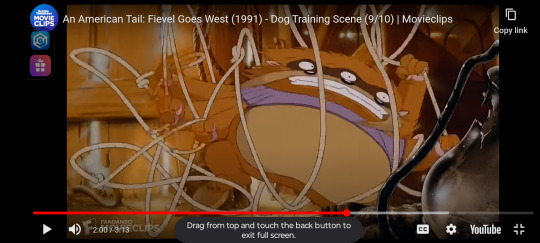
Every single bit of it OVER. AND OVER AGAIN. BY HAND.

Watch this clip again, slowed down. Watch all of this cat's many tiny fur tufts and fat rolls, and the wrinkles and expressive motions on this sheriff dog character. Someone had to draw all those moving around. They never had to. Who is the madman responsible for this. It wasn't some iconic Disney legend like Milt Kahl, and we know Do .Bluth was not here, so who the hell was it!
-The whiskers on Fievel and his tail being unnecessarily curled and punching IN TIME TO THE SONG as he is rooting his friend on.
-All these 'mummy' ropes, and the shadow on them.
-The shafts of light and the falling dirt and cave water drips at the beginning when Tiger prances about mockingly in the mine tunnel entrance.
-At 2:17 the bottle glass all reflecting OUR view of Tiger then shattering and the smoke on his slingshot and the excessively cool way Tiger twirls it around and then pockets it like a gun, complete with "action movie/fancy anime fight" style camera panning round and down his body in towards the holster.
-Look at the part at 2:06 with the punching dummy, from the clouds of dust and tiny straw bits that fly out when Tiger hits it, to all the different camera angles and the way they chose to bounce from third to first to third person again: look at when Tiger rushes up at the scarecrow with a pitchfork. They add 'camera shake' as a way to simulate the off balanced way he as a fat, clumsy, but now highly enthused excitable character specifically would run!
-ALL THOSE FEATHERS

OH MY GOD
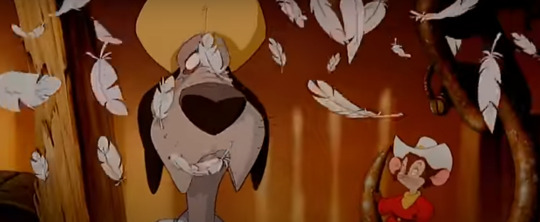
They drew the movement of ALL THOSE FUCKING ***FEATHERS!!!!😱***
This isn't even a major scene. But it's taken so thoroughly seriously. This is pure art. This is pure gluttonous showing off. That is brilliant. I really cannot believe how strong this lives up.
Well done brain, you rightfully deserved pushing this on me for so many years.
#fievel goes west#animation#classical music#furries#steven spielberg#movie soundtrack#epic moments#training montage#tiger#cowboy movie#don bluth style#nineties animation#kids film#special effects#film stills#adhd brain#2d animation#nostalgia#vhs#Youtube#an american tail#anthro#inbetween#richard williams#amblin#storytelling#traditional art#bogleech
22 notes
·
View notes
Text
I need to get some cleaning done tomorrow and need to focus on that so I'm going to try to see how productive I can be with the 3 OG X-Men movie soundtracks on in the background



#x men#fox xmen#x men movies#soundtrack#classical music#background music#movie soundtrack#ost#adhd#film soundtrack
9 notes
·
View notes
Text
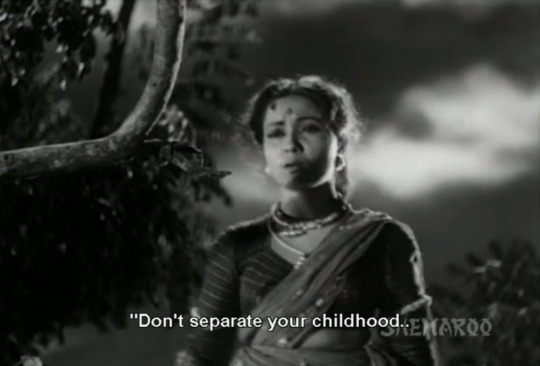
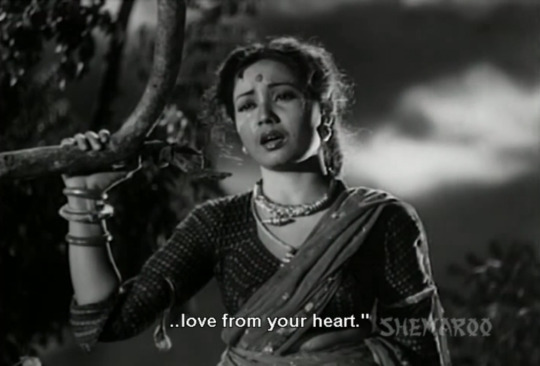
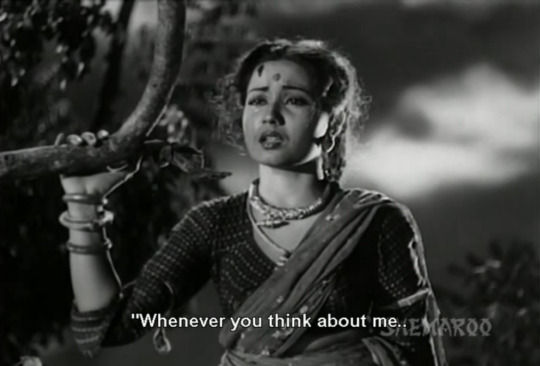
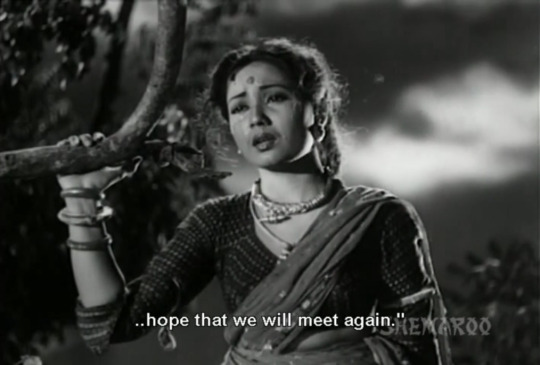
Baiju Bawra (1952) | dir. Vijay Bhatt
"Bachpan ki mohabbat ko Dil se na juda karna Jab yaad meri aaye Milne ki dua karna"
[ singer: Lata Mangeshkar | Lyrics: Shakeel Badayuni
| Music: Naushad ]
#baiju bawra#baiju bawra 1952#vijay bhatt#meena kumari#lata mangeshkar#naushad#shakeel badayuni#indian cinema#hindi cinema#bollywood#cinema#movies#films#old bollywood#world cinema#classic cinema#1950s#cinematography#south asian cinema#asian cinema#film soundtracks#movie soundtracks#film songs#movie songs#indian movies#hindi movies#bollywood movies#bollywood songs#hindi songs#indian films
13 notes
·
View notes
Text
Had to leave 2001: A Space Odyssey in the final ten minutes because I was literally getting muscle cramps from having to plug my ears for the monolith music.
I'd been trying to get through to the end because I knew the movie was nearly over, but when there was a brief pause, and then the music started again, I tagged out.
Let me say this before I say anything else: This movie is a masterpiece of the highest order.
But also, I get why 16-year-old me was fucking BORED, and I get how someone watching it as an adult could be fucking BORED. Because I was sitting there going, "Okay, this has all been very nice to look at, but I feel like I'm on film number 3 with HAL here, and I know where THIS part goes, but I'm gonna need a thru-thread to justify this fucking thing."
And then the thru-thread happened.
And holy shit.
My only recollection of watching this movie back when I was 16 (I remind you, I am 41) is some very well-known shots of Dave and Hal, and also many recreations of The Dawn of Man sequence in various pop culture ways (the Barbie movie being the latest in a long line).
I think it's especially impressive, watching it now, how little screentime HAL actually has and how I felt so bad about what happened to him. A computer, built by men, is possibly fallible one time. And so two humans decide they'll need to take away his intelligence because it's a life or death situation. Even the human who seems to see HAL as a possible sentient intelligence doesn't try to talk to him about his concern. When it comes down to it, the two humans decide to harm the computer that's kept them alive so far, may have (only MAY HAVE) made one minor mistake, and has tried to be friendly with them (HAL wanting to see Dave's drawings kicked me in the ribs).
And then, when you see Haywood's recording to explain why they're going to Jupiter after Dave has brought HAL off-line so deeply that it triggers as a last-ditch effort explanation to the astronauts in case HAL has failed but the ship is still usable, you realize HAL was trying to give Dave a hint about the secret he was being forced to keep when he asked Dave if he'd noticed how ODD the security around their journey was.
But also, HAL--upon realizing the astronauts plan to harm him--immediately seeks violence. But that also reflects the Dawn of Man era where we see the first tool use being to smash bones. HAL is as human as the first human to pick up a bone and smash it down.
And what saves man is the use of simple tools a computer program can't replicate or control.
#2001: a space odyssey#classic film#movies with a soundtrack that make me go panicky#i will be able to watch it at home because i can control the volume#but that's a big no to any other theater experience
22 notes
·
View notes
Text

#Television Music#Cinematic Classical#Film Score#Video Game Music#Soundtrack#Film Soundtrack#2000s#2010s#2020s#USA#poll#Spotify
72 notes
·
View notes
Video
youtube
Michael Nyman, “The Heart Asks Pleasure First / The Promise” (Edit) The Piano: Music From The Motion Picture ℗1993 Michael Nyman Ltd Released on: 1993-01-01 Producer: Michael Nyman Composer Lyricist: Michael Nyman Album design and illustration Dave McKean "The Heart Asks Pleasure First" is based on a popular Scottish song entitled "Gloomy Winter's Noo Awa", set to the traditional tune "Lord Balgownie's Favourite". The final edit is similar to the Scottish song used in “Beethoven's Sunset” ( 25 Scottish Songs, Op. 108 - No. 2, Sunset)
#michael nyman#the heart asks pleasure first#edit#the piano#music#bso#motion picture#movie#film#1993#soundtrack#dave mckean#beethoven#sunset#25 Scottish Songs Op. 108 - No. 2 Sunset#scottish song#gloomy winter's noo awa#Lord Balgownie's Favourite#classical contemporary
6 notes
·
View notes
Text
Anonymous asked: What’s your favourite piece of classical music that you discovered through a film soundtrack?
What an interesting question to which I have had to really scratch my head and think a little. The main issue is that if you are, like me, one of those kids who was exposed to classical music and some of its canon from an early age then the question becomes harder to answer. Like many other children, I was taught to play musical instruments and have music lessons from about 6 years old onwards. Films, especially the more adult themed ones with a classical score, were something you discovered much later in your teens onwards. So I’m going to cheat a bit here and there. For example I can’t include Milos Forman’s classic movie ‘Amadeus’ because I was already familiar with a range of Mozart’s repertoire before watching it.
Predictably, I’m going have to start with Walt Disney’s classic film ‘Fantasia’ (1940). This was perhaps the first film I was truly exposed to classical music in all its glory. It was Disney’s love letter to classical music and I can still watch it with child-like wonder at the magnificent music set to an incredible animation.
I’m pretty sure that Igor Stravinsky almost certainly wasn't thinking of dinosaurs when he wrote his ballet The Rite of Spring. But Walt Disney and his talented team of animators decided to tell the story of these prehistoric creatures using the dramatic, angular sounds of Stravinsky's masterpiece. And it's become one of the most famous sequences of the 1940s film.
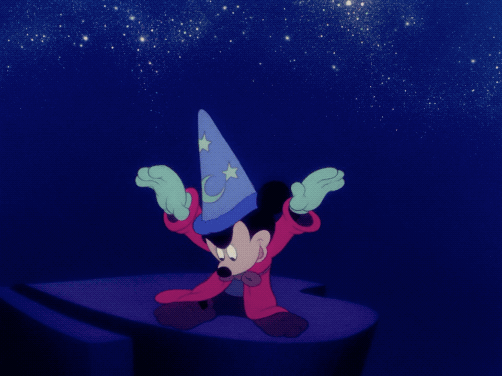
The score was performed by the Philadelphia Orchestra under Leopold Stokowski and was narrated by composer Deems Taylor was awesome. As magnificent was the music that Toccata and Fugue in D minor by J. S. Bach, selections from The Nutcracker Suite by Pyotr Ilyich Tchaikowsky, The Sorcerer’s Apprentice by Paul Dukas, Pastoral Symphony (Symphony No. 6) by Ludwig van Beethoven, and the “Dance of the Hours” by Amilcare Ponchielli, it was the last two pieces that left a real impression. Of course I’m talking about Night On Bald Mountain by Modest Moussorgsky, coupled with ‘Ave Maria’ by Franz Schubert.

I’m also going to add Léo Delibes’ Flower Duet (from the opera Lakmé). I used to hear this ad nauseam but not in a movie. This classic piece was the chosen soundtrack for the British Airways advertisement on television and in their departure lounges and flights. The ad - updated often - has been around in one form or another but with the same soundtrack since the 1980s. It was a huge feature of my childhood in the 90s. Whenever I boarded a flight in the Far East or South Asia or the Middle East to fly back home to Britain - because we lived overseas - you would hear this as you strapped yourself in to your seats.
As for my main list (in no particular order):
youtube
Second movement of Beethoven's Symphony No.7 from: The King’s Speech (2010)
The climactic scene where King George VI has to make his speech ‘unto the nations’ was made more powerful by this piece. Like King George VI and his personal battles with his voice, much speculation has taken place over what personal agony the musical piece reflects in Beethoven’s life, especially since sketches for the movement predate the symphony by several years.
One clue is that Beethoven, who conducted the premier in December of 1813 for the veterans of the Battle of Hanau, made an address to these veterans, saying: "We are moved by nothing but pure patriotism and the joyful sacrifice of our powers for those who have sacrificed so much for us." There is every reason to believe that the deep emotion of this movement was founded on anything but what he said it was. His sentiment had existed long before 1813, as had the wars. Napoleon was being repelled, and the symphony is overall joyous.
However, Beethoven was not the kind of man to casually dismiss sacrifice, and the concert was dedicated to veterans. I believe that this movement celebrates those military veterans who made sacrifices for their nation, in much the same way King George VI was asking his subjects in Britain and the Commonwealth in the fight against evil menace of Nazism and Fascism.
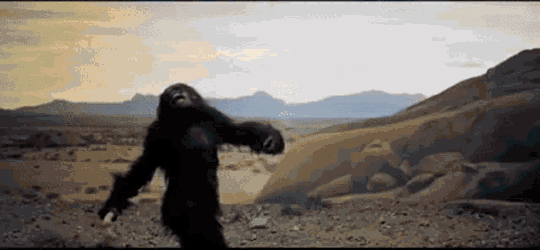
Ligeti's Lux Aeterna and Requiem from: 2001: A Space Odyssey (1968)
I hated it. I saw it as a teen and I thought something was wrong with the audio. I still hate the piece but at least I know who Ligeti is. It was way too avant garde for me back then and it remains so today. I think scratching your nails down a chalk board has more melody than a piece by Ligeti. Kubrick clearly loved his work and used it in his other films such as The Shining and Eyes Wide Shut.
Richard Strauss - Also Sprach Zarathustra from 2001: Space Odyssey (1968)
By contrast I loved it. Music can be the difference between a highly memorable scene and one that leaves viewers with an indifferent shrug. It’s hard to believe that this classical piece was used in the main opening scene of the film originally as a temporary place holder by Kubrick whilst he waited for the film composer, Alex North, from the full soundtrack. In the end Kubrick left Strauss in and it made all the difference.
youtube
Franz Schubert’s Piano Trio in E-Flat from: Barry Lyndon (1975)
The Piano Trio No. 2 in E-flat major for piano, violin, and cello, D. 929, was one of the last compositions completed by Franz Schubert in 1827 and one of the last pieces he heard being performed before he died. The track itself has been used in countless of movies over the decades such as The Hunger, Crimson Tide, The Piano Teacher, L'Homme de sa vie, Land of the Blind, Recollections of the Yellow House, The Way He Looks, The Mechanic, Miss Julie, The Congress, and the HBO miniseries John Adams. But I first heard it on Kubrick’s film Barry Lyndon and remember being captivated by the film and the music. I was a teen watching it my parents and the whole scene at the card table was beautifully directed and wonderfully lit. As I learned much later in life, Kubrick and his team invented new kind of film lens to be able to film in candlelight.
Handel's sarabande from: Barry Lyndon (1975)
The sarabande is traditionally the music written for a courtly dance in triple metre. Handel's version was composed for solo harpsichord at some point between 1703 and 1706 and first published in 1733. This classic piece is the 4th movement of the Cette pièce est le quatrième mouvement de la Suite in G minor composed for the harpsichord. Although the Sarabande was originally intended by its composer to be played solo on harpsichord, the orchestral version of the Sarabande is very well known these days thanks to the Barry Lyndon film. Moreover, the Sarabande is beloved by filmmakers and has been adapted several times for various films. It’s one of my favourite pieces and it reminds me of the English countryside for some reason rather than some formal court dance.
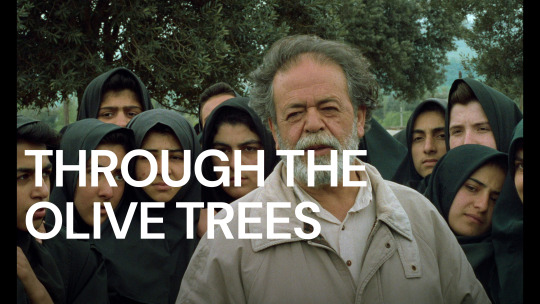
Domenico Cimarosa’s Concerto for Oboe in C Moll from: Though the Olive Trees (1994)
Directed by Abbas Kiarostami, this little known Iranian-French film was something I stumbled upon through my Norwegian mother who loved these kind of independent films when we lived in South Asia as an antidote to all the Bollywood films we children enjoyed. Kiarostami’s film traces the trouble arising when the romantic misfortune of one of the actors on a film set - a young man who pines for the woman cast as his wife, even though, in real life, she will have nothing to do with him - leaves the director caught in the middle. In hindsight I can now say it was a metafictional masterpiece. Kiarostami contemplates cinema and its romantic fallacies. The film is gorgeously grounded in Northern Iran’s folk traditions and with a soft focus on its shaken yet convalescent landscape. It’s a warmhearted tale that explores what happens when love goes unrequited - which was surprisingly relevant to a teen with raging hormones at the time.

Ralph Vaughan Williams’ Fantasia on a Theme by Thomas Tallis from: Master and Commander: The Far Side of the World (2003)
A classical musical masterpiece in a masterful cinematic movie - both epic in every sense of the word. As a former British Army combat pilot it’s the only film that made me have a smidgen of sympathy with the Royal Navy. It was one of the first films I was allowed to go and see at the cinema itself as a teen. The film is almost faultless in terms of acting, directing, cinematography, and authentic detail. It even made me go and read one or two of the books by Patrick O’Brian. How Peter Weir never won an Oscar for directing I shall never know.
Vaughan Williams’s Fantasia on a Theme by Thomas Tallis is a 15-minute (or so) work for double string orchestra and string quartet, based on a melody by the 16th century composer Thomas Tallis. The quartet traditionally sits away from the orchestra in performance, to create an atmospheric antiphonal (alternating voices) effect. It is often known simply as the ‘Tallis Fantasia’. The tune is from a setting of Psalm 2 that Tallis wrote in 1567. It originally sets the words ‘Why fumeth in sight: The Gentils spite, In fury raging stout? Why taketh in hond: the people fond, Vayne things to bring about?’ It was in 1910 at a festival that Vaughan Williams himself conducted the London Symphony Orchestra in the first performance, which was followed in the same concert by Elgar conducting his own The Dream of Gerontius. Vaughan Williams, in his late 30s, was already establishing himself as a major name, but the Tallis Fantasia raised his profile even higher, not least because the concept of harking back to the 16th century was a comparatively new one.
The piece by Vaughn Williams is what has stayed with me throughout the years. In a nod to Proust, I chiefly identify the piece with reflections of my time on the battlefields of Helmand during my time in Afghanistan and especially seeing wounded friends and comrades long after we got back home from war.
youtube
Carl Orff’s Carmina Burana from: Excalibur (1981)
I was already familiar with bits and pieces from Wagner’s operas - played loudly in our home by my parents - but I must admit this classic piece by Carl Orff I first heard watching John Boorman’s magical and majestical film about King Arthur and his knights of the Round Table. I know this piece has been used endlessly in other films and even gained fame as a men’s aftershave advertisement (so my father says) but I first heard it watching this film.
John Boorman’s 1981 fantastical retelling of Thomas Mallory’s Le Morte d’Arthur is, to quote Nicol Williamson’s Merlin in the film, “A dream to some. A nightmare to others!” It can sometimes come across as an episodic and hammy sword and sorcery tale, but I saw it as clever and satisfying retelling of an evergreen myth. I had read read Mallory’s epic books and so my expectations were unduly high. For the most part they were met and then some. Boorman took an abstract approach that shows us Arthur’s (unnamed) Kingdom, a place out of time, in several stages of transition; from dark to golden age, via loss of innocence, and painfully bloody rebirth. Excalibur arose out of the ashes of Boorman’s earlier attempt to bring J.R.R. Tolkien’s The Lord of the Rings to the screen (ironically after trying to get a filmic retelling of the Merlin myth off the ground).
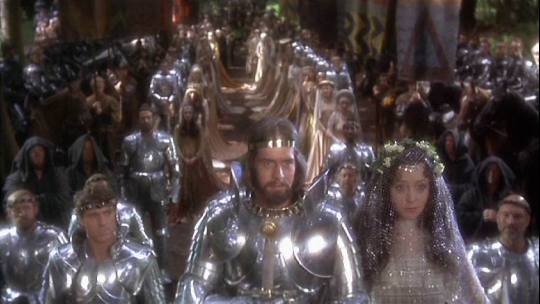
Excalibur is a cautionary tale. The characters are all struggling to find their place in the world, to maintain harmony with nature. Merlin says poignantly of Excalibur to Arthur, “It was forged when the world was young, and bird and beast and flower were one with man, and death was but a dream.” The film is a longing for a golden age, and the struggle to balance the warring natures of honour and goodness with human greed and jealousy. Surely the most rousing image is when Percival has returned the Grail to Arthur who, rejuvenated, also recovers Excalibur from Guinevere (now a nun, to atone for her adultery with Lancelot). She has kept it safe, knowing her once and future king would one day seek its power. Merlin is unfrozen by Arthur, and even Lancelot, a raggedy wild man driven into exile by his own shame, heeds his true king’s call. Arthur rides out with his knights and these fellow warriors through a re-blossoming countryside to do battle with Mordred for the soul of the land, to Carl Orff’s stirring music.
The name of Orff’s piece has Latin roots. 'Carmina' means 'songs', while 'Burana' is the Latinised form of Beuren, the name of the Benedictine monastery of Benediktbeuren in Bavaria. So, Carmina Burana translates as Songs Of Beuren, and refers to a collection of early 13th-century songs and poems that was discovered in Beuren in 1803 - although it has since been established that the collection originated from Seckau Abbey, Austria - and is now housed in the Bavarian State Library. The songs (over 1000 of them) were written in a mix of Latin, German and medieval French by the Goliards, a band of poet-musicians comprising scholars and clerical students, who celebrated with earthy humour the joys of the tavern, nature, love and lust. Although Orff set the original texts, he chose not to use the primitive musical notation that accompanied some of the songs. The collection was first published in Germany in 1847, but it wasn’t until 1934 that Orff came across the texts; a selection had been translated into English and formed part of a publication called Wine, Women And Song. With the help of Michael Hofmann, a law student and Latin scholar, Orff chose 24 songs and set them to music in what he termed a “scenic cantata”.
It was in this form that it was first heard on June 8, 1937, in Frankfurt, under its full title Carmina Burana: Cantiones Profanae Cantoribus Et Choris Cantandae Comitantibus Instrumentis Atque Imaginibus Magicis (Songs Of Beuren: Secular Songs For Singers And Choruses To Be Sung Together With Instruments And Magic Images) Quite a mouthful! After the triumphant premiere of Carmina Burana, Orff, then 41, wrote to his publishers: “Everything I have written to date, and which you have, unfortunately, published, can be destroyed. With Carmina Burana my collected works begin.” However, nothing Orff subsequently wrote ever came close to approaching the popularity of Carmina Burana. Oh dear.
youtube
Richard Wagner’s Siegfried’s Funeral March (from the opera Götterdämmerung) from: Excalibur (1981)
The film almost plays like a screen Opera - it is a heightened reality, a world anew. One where sex, jealousy and pride threaten to undo the mystical balance and ties between the King and the land. A powerful aid to that feeling is the superb score which utilises music such as Siegfried’s Funeral March by Wagner, and O Fortuna, a medieval poem set to music by Carl Orff. Boorman was determined to squeeze as much of the legend into his film’s running time as possible, chopping and condensing characters, and switching acts around. He created a three-act saga - the dark ages and the birth of Arthur, a period of brutality and superstition; the rise of Camelot and its age of reason, law, and dawning of Christianity; and the final descent into chaos and wasteland, where a frail Arthur commands the Round Table knights to seek out the Grail. Arising out of this a final battle commences for the soul of the land and the people, a sense of renewal with a promise of a new age to come. Boorman called it the “past, present and future of humanity.”
Richard Wagner composed his opera Götterdämmerung between 1869 and 1874. It is the last of the four operas that make up Wagner’s Der Ring des Nibelungen cycle, a project that had taken him over 25 years to complete. The opera is much renowned for its orchestral sequences, and these are often performed as concert extracts. Siegfried's Funeral March is taken from Act Three after Siegfried has been murdered by Hagen. Following his murder at the hands of Hagen, the death knell of “Siegfried’s Funeral March” opens with funereal timpani as Siegfried’s body is placed on his shield and carried off by the vassals. The music vacillates from deep mourning and rage-filled outbursts to the majesty of the “Hero” motif, brought out in bold relief at the centre of the movement.The whole opera is made up of musical motives from previous operas that tell of Siegfried's background, including the Volsung theme, Siegmund and Sieglinde's theme, the Sword, Brünnhilde's love theme and the curse of the Ring.
youtube
Richard Wagner’s Ride of the Valkyries (Die Walküre) from: Apocalypse Now (1979)
Francis Ford Coppola's Vietnam War phantasmagoria is an epic fresco oozing with madness. It is a madness that manages to escape from the frame and infect the director and his team, turning the film into a legend. It is impossible not to talk about this film without mentioning the Dantesque shooting of the film. A typhoon that destroyed the sets, a heart attack that nearly killed Martin Sheen, a Brando who was more obese and obtuse than ever, who arrived on the set without knowing his lines, and a director at the end of his rope physically and psychologically, on the verge of divorce and suicide. Instead of taking four months to complete, the shoot lasted 15 months. The analogy with the hell of Vietnam is obvious.
The film itself is about Benjamin Willard, a special forces captain, who is given a highly perilous mission: to find and assassinate Colonel Kurtz, a renegade who has set up his headquarters on the Cambodian border. To accomplish his mission, Willard must travel up a river in a small patrol boat with a handful of men. We follow Willard sinking into the madness and insanity of this war, personified by the character of Colonel Kurtz, an obese Buddhist, a true godfather of the Vietnamese jungle. Apocalypse Now is in fact a mirror for the spectator, it plays on our feelings about the Vietnamese conflict, and this is what sets it apart from other great war films. It is a physical and very real journey through Vietnam, but also an inner journey for its hero, Willard, a drug addict and alcoholic, which will allow Coppola to make his denunciation of the war. After watching this movie over several years I’ve come to regard Coppola’s movie as more than just a war movie but also an hallucinatory trip, as anxiety provoking as possible, about the human soul lost inside itself.
For a movie that had two of my greatest loves - combat helicopters and Wagner - the film surprisingly didn’t inform my future career path as a combat pilot for the British Army. I was too young as a teen and caught up with other feminine things girls of my age did. But watching it retrospectively I’m sure it had some unconscious influence on me. I noticed things more with each viewing such as before Jim Morrison's paradoxical and delightful prologue, it is the helicopter blades that open Apocalypse Now. The jerky noise that spatialises this mortifying horizon is a motif that will be the melodic line of the entire film. In crosshatching, it truncates reality and allows the initial confusion of a man in reverse who opens his eyes on an uncertain world. The fan in the hotel room is not the air-conditioned shelter of war. Everything, from then on, is under the sign of duality.

Then of course we have the euphoric scene but no less horrifying than the helicopter attack by Kilgore and his men to lay waste to a village so that they could surf. And all done to the terrifying bombast of Wagner’s Ride of Valkyries. It’s a demented scene but also so visually lyrical. Wagner’s Ride of the Valkyries is sadistically perfect. It’s a perfect mythical metaphor of the valkyries who majestically flew in the sky and decided who died in battle from above. Of course the symbolism of Wagner - wrongly tarred with its fascist connotations - as a place holder for Western imperialism over the Vietnamese is not lost on the viewer. It’s a clever piece of juxtaposition.
Armies have of course used music in warfare for millennia. The deployment of musicians - from trumpeters to drummers - in battle was useful in instilling regimentation and rhythmic purpose for soldiers; and in days before radio, in carrying specific orders across the battlefield. As well as unifying an army - it could potentially disorient the enemy, or as Kilgore eruditely elaborates: ‘We use Wagner, it puts the shits up the slopes. My boys love it!’. So what we are seeing is an age old military tactic being given a modern twist. This has already been established by the notion of an air cavalry, trading their horses for helicopters - which gets further embodied by Kilgore’s wearing of a cowboy hat, common to the Western film genre. The symbolism of linking old and new - ancient and modern, history and the present - occurs throughout Apocalypse Now, as it does in the original novella Heart of Darkness. It indicates an uncomfortable continuum, a never ending foreboding cycle. That beneath the fragile veneer of civilisation, humanity is endlessly repeating barbarism - a cycle foreshadowed by helicopter/fan blades at the start of the film which also loops back to become the end of the film - itself a cycle that won’t end.
When I flew combat helicopters over in Afghanistan we were banned from playing music in our cockpit. It’s simply not practical because you need to be aware of all your aural cues of what the hell is going on around you as every mission is task intensive. You’re focused on a mission where the shit can hit the fan such as coming under rocket attack at any second especially if you’re on a night mission. In theory you could, as anyone with some audio equipment and electronics knowledge could wire in a 3.5mm headphone jack and hook up your music into your own helmet. I knew some pilots who broke the ban and did this. They would get their clever avionic ground staff technician crew to put in a some sort of patch cord that could plug through to their helmet ICS - in return you get them a case of beer. I’m not telling where we got the beer from.
Other honourable mentions:
Second movement of Schumann's Piano Quintet from: Fanny and Alexander (1982)
Gaetano Donizetti’s Lucia di Lammermoor "Il dolce suono" from: The 5th Element (1997)
Rodrigo's Concierto de Aranjuez from: Brassed Off (1996)
Maurice Ravel’s Trio en la mineur pour piano, violon et violoncelle, Sonata for Violin and Cello, Violin Sonata #2 in G, and Berceuse Sur le Nom De Gabriel Fauré from: Un Coeur en Hiver/A Heart in Winter (1992)
Mozart’s Divertimento in D major, K. 136 from: Out of Africa (1985)
Carl Orff - Schulwerk Volume 1: Musica Poëtica - Gassenhauer from Badlands (1973)
Puccini’s O mio babbino caro (aria from the opera Gianni Schicchi) from: A Room with a View (1985)
Verdi’s La forza del destino (the Force of Destiny) overture from: Jean de Florette (1986)
Mozart’s Letter Duet (from The Marriage of Figaro) from : The Shawshank Redemption (1994)
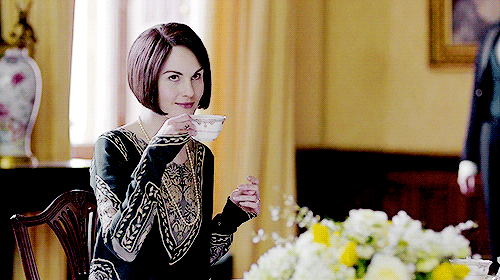
Thanks for your question
#ask#question#music#film#soundtrack#movie#cinema#film soundtrack#composer#classical music#arts#culture#personal
63 notes
·
View notes
Text

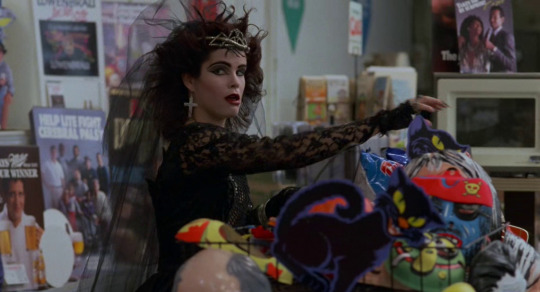




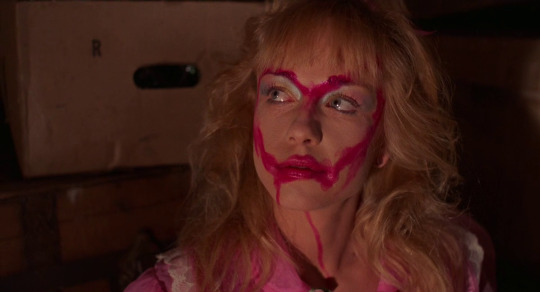
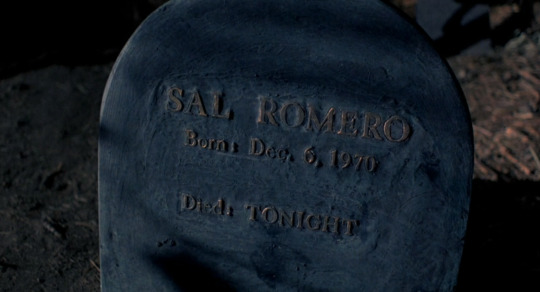
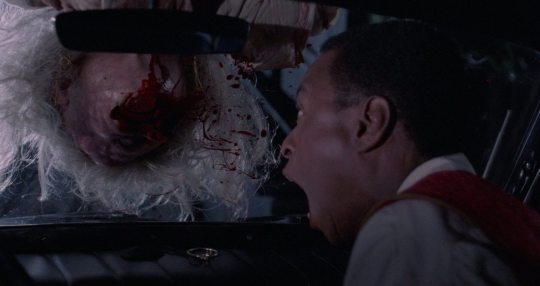
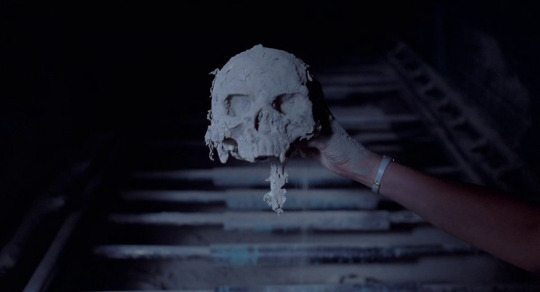
Night of the Demons (1988)
"Do you guys have sour balls?"
"Why, sure we do."
"Too bad, I bet you don't get many blowjobs."
#night of the demons#horror imagery#gore tw#1988#american cinema#horror film#kevin tenney#joe augustyn#cathy podewell#alvin alexis#billy gallo#linnea quigley#amelia kinkade#jill terashita#allison barron#hal havins#harold ayer#lance fenton#donnie jeffcoat#philip tanzini#karen ericson#late to this one ofc as I'm late to many of the horror classics. tried to watch this back in my uni days but i accidentally ended up#watching the 2009 remake (very meh). finally getting to this and i think it deserves the hype! a genuinely witty script full of#zingers‚ an iconic Lin Quigley appearance (second only to Return of the Living Dead for epoch defining Quigley moments) and a brilliant#performance from Kinkaid as the possessed party pooper (her frantic dance scene to a Bauhaus bop is‚ without hyperbole‚ a transcendent#moment in 80s horror and one of The scenes of all time). also ends on a bravura bit of irreverent silliness and has a pretty awesome#soundtrack to boot. I'm unexpectedly all in for this one! far outdid my expectations and made me intrigued for the (presumably awful)#sequels.#an undeniably essential part of the late 80s cheapo dtv horror canon
7 notes
·
View notes